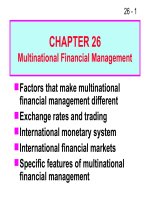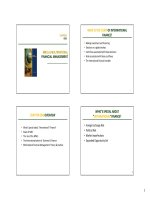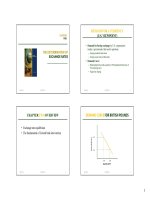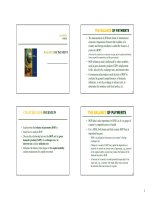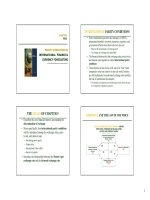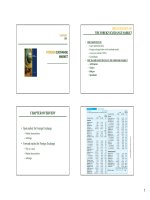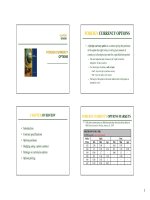Lecture Multinational financial management: Lecture 2 - Dr. Umara Noreen
Bạn đang xem bản rút gọn của tài liệu. Xem và tải ngay bản đầy đủ của tài liệu tại đây (247.03 KB, 14 trang )
Lecture
2Multinational Financial
Management:
An Overview
International
Business Methods
International trade involves exporting
and/or importing.
Licensing allows a firm to provide its
technology in exchange for fees or some
other benefits.
Franchising obligates a firm to provide a
specialized sales or service strategy,
support assistance, and possibly an initial
investment, in exchange for periodic fees.
International
Business Methods
Firms may also penetrate foreign markets
by engaging in a joint venture (joint
ownership and operation) with firms that
reside in those markets.
Acquisitions of existing operations in
foreign countries allow firms to quickly
gain control over foreign operations as
well as a share of the foreign market.
International
Business Methods
Firms can also penetrate foreign markets
by establishing new foreign subsidiaries.
• Many MNCs use a combination of methods
to increase international business.
In general, any method of conducting
business that requires a direct investment
in foreign operations is referred to as a
direct foreign investment (DFI).
International Opportunities
• Investment opportunities
– The marginal returns on MNC projects are
above those of purely domestic firms since
MNCs have expanded opportunity sets of
possible projects from which to select.
• Financing opportunities
– MNCs can obtain capital funding at a lower
cost due to their larger opportunity set of
funding sources around the world.
International Opportunities
Cost-Benefit Evaluation for
Purely Domestic Firms versus MNCs
Marginal
Return on
Projects
Marginal
Cost of
Capital
Purely
Domestic
Firm
Investment
Opportunities
MNC
MNC
Purely
Domestic
Firm
Financing
Opportunities
Appropriate
Size for Purely
Domestic Firm
X
Appropriate
Size for MNC
Y
Asset Level
of Firm
International Opportunities
• Opportunities in Europe
– the Single European Act of 1987
– the removal of the Berlin Wall in 1989
– the inception of the euro in 1999
– the expansion of the European Union
International Opportunities
• Opportunities in Latin America
– the North American Free Trade Agreement
(NAFTA) of 1993
– the removal of investment restrictions
• Opportunities in Asia
– the removal of investment restrictions
– the impact of the Asian crisis in 1997-1998
Exposure to International Risk
• International business usually increases
an MNC’s exposure to:
exchange rate movements
foreign economies
political risk
Overview of an MNC’s Cash
Flows
Profile A: MNCs Focused on International Trade
U.S.based
MNC
Payments for products
U.S. Customers
Payments for supplies
U.S. Businesses
Payments for exports
Foreign Importers
Payments for imports
Foreign Exporters
Overview of an MNC’s Cash
Flows
Profile B: MNCs Focused on International Trade and
International Arrangements
U.S.based
MNC
Payments for products
U.S. Customers
Payments for supplies
U.S. Businesses
Payments for exports
Foreign Importers
Payments for imports
Foreign Exporters
Fees for services provided
Foreign Firms
Fees for services received
Foreign Firms
Overview of an MNC’s Cash
Flows
Profile C: MNCs Focused on International Trade,
International Arrangements, and Direct Foreign
Investment
Payments for products
U.S. Customers
Payments for supplies
U.S.based
MNC
Payments for exports
Payments for imports
U.S. Businesses
Foreign Importers
Foreign Exporters
Fees for services provided
Foreign Firms
Fees for services received
Foreign Firms
Funds remitted back
Foreign Subsidiaries
Investment funds
Foreign Subsidiaries
References
• Adopted from South-Western/Thomson
Learning © 2006


